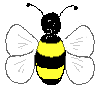Or search by topic
Number and algebra
Geometry and measure
Probability and statistics
Working mathematically
Advanced mathematics
For younger learners
Honey Bees



- Problem
- Solutions

One gallon of honey provides fuel for one bee to fly about seven million miles.
Roughly how many bees could fly one thousand miles if they had ten gallons of honey?
If you liked this problem, here is an NRICH task which challenges you to use similar mathematical ideas.
You may also like
Fixing the Odds
You have two bags, four red balls and four white balls. You must put all the balls in the bags although you are allowed to have one bag empty. How should you distribute the balls between the two bags so as to make the probability of choosing a red ball as small as possible and what will the probability be in that case?
Scratch Cards
To win on a scratch card you have to uncover three numbers that add up to more than fifteen. What is the probability of winning a prize?
Escalator
At Holborn underground station there is a very long escalator. Two people are in a hurry and so climb the escalator as it is moving upwards, thus adding their speed to that of the moving steps. ... How many steps are there on the escalator?

